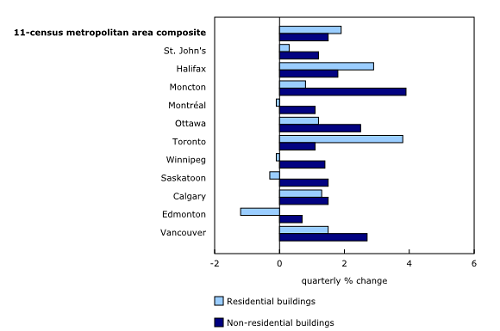 Sunday, May 12, 2024
Sunday, May 12, 2024  Sunday, May 12, 2024
Sunday, May 12, 2024 
Statistics Canada reports that the residential building construction costs increased 1.9% in the second quarter, following 1.8% growth in the previous quarter. Meanwhile, non-residential building construction costs rose 1.5% in the second quarter, following a 1.7% increase in the previous quarter.
Year over year, construction costs for residential buildings in the 11-census metropolitan area (CMA) composite rose 7.5% in the second quarter, whereas non-residential building construction costs rose 7.0%. Toronto (+13.0%) led year-over-year growth in construction costs for residential buildings, while Moncton (+12.5%) led growth for non-residential building.
Skilled labour shortages, cost of materials and labour rate changes were reported by contractors as key factors impacting the construction sector.
While a majority of CMAs recorded quarterly growth in residential building construction costs in the second quarter, four CMAs reported decreases. Costs to construct residential buildings increased the most in Toronto (+3.8%) and Halifax (+2.9%), whereas Edmonton (-1.2%) recorded the largest decline in costs, followed by Saskatoon (-0.3%).
The diverging price movements of key construction materials impacted residential construction costs. In the second quarter, prices continued to rise for cement and ferrous metals, while they declined for lumber, plastics and non-ferrous metals.
In the 11-CMA composite, the cost to build high-rise apartments (+2.8%) grew the most of all residential buildings in scope for the survey, followed by single-detached homes (+1.8%).
Non-residential building construction costs grew the most for structural steel framing (+2.6%) in the second quarter, followed by concrete (+2.5%) and metal fabrications (+2.4%) divisions. The continued increase in concrete prices drove the rise in costs, as concrete is a major component in non-residential construction.
Of all non-residential buildings surveyed, the cost to build factories and warehouses (both up 1.8%) rose the most in the 11-CMA composite.
Costs to construct non-residential buildings increased the most in Moncton (+3.9%), Vancouver (+2.7%) and Ottawa (+2.5%).